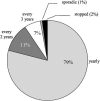The frequency of Pap smear screening in the United States
- PMID: 15009779
- PMCID: PMC1492158
- DOI: 10.1111/j.1525-1497.2004.21107.x
The frequency of Pap smear screening in the United States
Abstract
Background: U.S. professional medical societies and the national health systems of all other industrialized nations recommend that most women need not undergo Papanicolaou (Pap) smear screening annually. There are no data, however, regarding the frequency at which women actually undergo screening.
Objective: To describe the frequency of cervical cancer screening in the United States.
Design: National Health Interview Survey, a cross-sectional population-based telephone survey conducted by the National Center for Health Statistics.
Participants: Representative sample of U.S. women age 21 and older who denied a history of cancer (N = 16,467).
Measurements: Pap smear screening frequency, categorized as no regular screening or screening at 1 of 3 discrete screening intervals (every year, every 2 years, or every 3 years) based on each woman's reported number of Pap smears in the previous 6 years.
Results: The vast majority (93%) of American women report having had at least one Pap smear in their lifetime. Among women with no history of abnormal smears, 55% undergo Pap smear screening annually, 17% report a 2-year screening interval, 16% report being screened every 3 years, and 11% are not being screened regularly. Even the very elderly report frequent screening-38% of women age 75 to 84 and 20% of women age 85 and older reported annual Pap smears. Overall, 20% of women reported having had at least one abnormal Pap smear. Among these women, rates of frequent Pap smear screening are considerably higher-80% undergo annual screening, with only a modest decline in screening frequency with increasing age.
Conclusions: The majority of American women report being screened for cervical cancer more frequently than recommended. Lengthening the screening interval would not only reduce the volume of specimens that cytotechnologists are required to read, but would also reduce the follow-up testing after abnormal smears.
Figures




References
-
- Frame PS, Frame JS. Determinants of cancer screening frequency: the example of screening for cervical cancer. J Am Board Fam Pract. 1998;11:87–95. - PubMed
-
- Fahs MC, Mandelblatt J, Schecter C, Muller C. Cost effectiveness of cervical cancer screening for the elderly. Ann Intern Med. 1992;117:520–7. - PubMed
-
- American College of Physicians. Guidelines: screening for cervical cancer. In: Eddy DM, editor. Common Screening Tests. Philadelphia, Pa: American College of Physicians; 1991. pp. 413–4.
Publication types
MeSH terms
LinkOut - more resources
Full Text Sources
Medical
Research Materials
